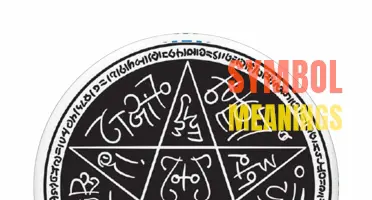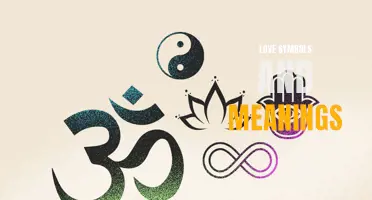
December is a month filled with anticipation and excitement as it marks the end of one year and the beginning of a new one. The name of the month itself, derived from the Latin word decem meaning ten, initially referred to its position as the tenth month in the ancient Roman calendar. However, due to changes in the calendar system over the years, December became the twelfth month. Symbolically, December is associated with reflection, renewal, and celebration. It is a time to look back on the past year and make plans for a brighter future. December also holds a special significance as it coincides with various religious and cultural holidays, such as Christmas, Hanukkah, and Kwanzaa, bringing people together in a spirit of unity and joy. Join us as we delve into the deeper meaning and symbolism of this enchanting month.
What You'll Learn
- What is the meaning of December in different cultures and religions?
- What symbolism is associated with the month of December?
- How does the winter solstice play a role in the symbolism of December?
- Are there any specific holidays or celebrations in December that have symbolic meaning?
- How has the meaning and symbolism of December evolved throughout history?

What is the meaning of December in different cultures and religions?
December is a month that holds significant meaning in various cultures and religions around the world. As the last month of the year, it is a time of reflection, celebration, and anticipation for the future. Let's explore the different meanings of December in various cultural and religious contexts.
In Christianity, December is closely associated with the celebration of Christmas, the birth of Jesus Christ. Christians believe that Jesus was born on the 25th of December, although the exact date is unknown. December is a time when Christians come together to remember and celebrate the birth of their savior. It is a month full of traditions and customs, such as decorating Christmas trees, exchanging gifts, and attending church services. Christians also use this time to reflect on the meaning of Jesus' birth and the hope and salvation he brings.
In Judaism, December falls during the festival of Hanukkah, also known as the Festival of Lights. Hanukkah is an eight-day festival that commemorates the rededication of the Second Temple in Jerusalem after it was desecrated by the Seleucid Empire. The central symbol of Hanukkah is the menorah, a nine-branched candelabrum. Each night, one additional candle is lit until all eight candles, plus the shamash (helper candle), are illuminated. The festival celebrates the miracle of the oil that lasted for eight days, despite there only being enough oil for one day. December holds special religious significance for Jews as they come together to light the menorah, sing songs, and play the dreidel game.
In Pagan traditions, December marks the winter solstice, the shortest day and longest night of the year. It is a time when Pagans celebrate the rebirth of the sun and the return of longer days. Many Pagan cultures honor this time with various rituals and traditions, such as lighting bonfires, decorating evergreen trees, and exchanging gifts. The winter solstice holds symbolic meaning for Pagans, representing the cycle of life, death, and rebirth.
In Hinduism, December is a significant month as it marks the celebration of various festivals. One of the most widely celebrated festivals in India during December is Diwali, also known as the Festival of Lights. Diwali is a five-day festival that symbolizes the victory of light over darkness, knowledge over ignorance, and good over evil. Hindus celebrate Diwali by lighting oil lamps, decorating their homes, exchanging sweets, and bursting fireworks. It is a time of joy, new beginnings, and the reaffirmation of one's commitment to spiritual enlightenment.
December also holds cultural significance in other parts of the world. In Mexico, for example, December 12th is celebrated as the Feast of Our Lady of Guadalupe, honoring the Virgin Mary. In Japan, December is a month filled with preparations for the New Year, known as Oshogatsu. Families come together to clean their homes, decorate with pine branches and bamboo, and celebrate with traditional foods.
In conclusion, December holds varying meanings in different cultures and religions around the world. Whether it is the celebration of Christmas, Hanukkah, the winter solstice, or festivals like Diwali, people come together during this special month to reflect, celebrate, and embrace the meaning and significance of their respective traditions. It is a time of joy, hope, and renewal as people look forward to the start of a new year.
Decoding the AC Symbols in Your Car: Understanding the Meaning of the Dashboard Icons
You may want to see also

What symbolism is associated with the month of December?
Symbolism associated with the month of December
December is the twelfth and final month of the year, and it holds a special place in many cultures and traditions around the world. This month is often associated with winter, holidays, and the end of the year, and it carries various symbols that represent these themes.
- Winter: December is a time when many countries experience winter weather, and it is often associated with snow and cold temperatures. The symbol of snowflakes is commonly seen in December decorations and artwork, representing the beauty and uniqueness of each individual.
- Holidays: December is the month of many significant holidays, including Christmas, Hanukkah, Kwanzaa, and New Year's Eve. These holidays are associated with their own unique symbolism:
- Christmas: The nativity scene, depicting the birth of Jesus Christ, is a common symbol of Christmas. Other symbols include the Christmas tree, wreaths, and ornaments, representing peace, joy, and the spirit of giving.
- Hanukkah: The Menorah, a nine-branched candelabrum, is a central symbol of Hanukkah. It represents the miracle of the oil that lasted for eight days, and each night of the holiday, an additional candle is lit.
- Kwanzaa: Kwanzaa is a seven-day celebration of African heritage and culture. The Kinara, a candle holder with seven candles, is the most recognized symbol of Kwanzaa. Each candle represents one of the seven principles of the holiday.
- New Year's Eve: The symbol of a clock ticking to midnight represents the passing of time and the transition to a new year. Fireworks, champagne, and the number "2022" are also commonly associated with New Year's Eve.
- Endings and new beginnings: December marks the end of the year, making it a time for reflection, closure, and setting new goals. The symbol of a broken or old calendar being replaced by a brand new one represents this transition, encouraging people to leave the past behind and embrace the possibilities of the future.
- Family and togetherness: December is a time when many people gather with their loved ones. The symbol of a family gathered around a table for a holiday meal represents the importance of unity, love, and connection during this time of the year.
- Hope: December is often associated with hope for a better future. As the year comes to a close, people look forward to new beginnings and brighter days ahead. The symbol of a candle burning in the darkness represents the light and hope that guides us through difficult times.
In conclusion, the month of December carries various symbols that represent winter, holidays, endings, and new beginnings. These symbols reflect the beauty of the season, the joy of celebrations, and the hope for a brighter future. They serve as a reminder of the values and traditions that bring people together during this special time of the year.
Understanding the Symbolic Meanings behind Navajo Sand Painting
You may want to see also

How does the winter solstice play a role in the symbolism of December?
The winter solstice is a significant event that takes place in December, and it plays a vital role in the symbolism of this month. In many cultures and traditions, the winter solstice is a time of reflection, renewal, and rebirth. It marks the shortest day and the longest night of the year and holds various symbolic meanings.
One of the most common symbolisms associated with the winter solstice is the return of light. As the days start to grow longer after the solstice, it represents the triumph of light over darkness. This symbolism is seen in many religious and spiritual practices, where candles are lit to signify hope and the coming of brighter days. For Christians, the winter solstice aligns with the celebration of Christmas, the birth of Jesus, who is considered the light of the world.
The winter solstice is also closely associated with nature and the cycles of the Earth. In Pagan and Wiccan traditions, it is celebrated as Yule, a festival that honors the rebirth of the sun and the renewal of life. It is a time to connect with the natural world, to acknowledge the changing seasons, and to celebrate the return of light and warmth.
Furthermore, the winter solstice holds a symbolic significance in terms of personal growth and introspection. As the natural world goes through a period of dormancy, it serves as a reminder for individuals to slow down, reflect on the past year, and set intentions for the future. Many people use this time to evaluate their goals, make resolutions, and plan for the year ahead.
The symbolism of the winter solstice in December also extends to cultural and historical traditions. In ancient civilizations, such as the Mayans and the Druids, the solstice was viewed as a sacred time when celestial alignments held great significance. Monumental structures like Stonehenge were aligned to mark the winter solstice sunrise and sunset, showcasing the importance of this event in their cultures.
Overall, the winter solstice plays a multifaceted role in the symbolism of December. It represents the return of light, the cycles of nature, personal growth, and historical traditions. It serves as a time for reflection, renewal, and setting intentions for the future. Whether celebrated as a religious holiday or a secular observance, the winter solstice holds deep meaning and connects individuals to the larger rhythms of the Earth and the universe.
The Power of Symbols: Exploring the Meanings Behind Symbols That Represent Growth
You may want to see also

Are there any specific holidays or celebrations in December that have symbolic meaning?
December, the last month of the year, is filled with various holidays and celebrations around the world. Many of these festivities hold significant symbolic meanings that are cherished by different cultures and religions. Let's explore a few of these holidays, each with its unique symbolism.
Christmas:
One of the most widely celebrated holidays in December is Christmas, which commemorates the birth of Jesus Christ. This holiday holds deep symbolic meaning for Christians worldwide. The Nativity story symbolizes hope, love, and the coming of light into the world. The Christmas tree represents everlasting life, while the star on top symbolizes the Star of Bethlehem, guiding the shepherds and wise men to the birthplace of Jesus. The exchange of gifts symbolizes love and generosity.
Hanukkah:
Hanukkah, also known as the Festival of Lights, is a Jewish holiday that usually falls in late December. It commemorates the miracle of the oil in the ancient Temple in Jerusalem. The symbolism of Hanukkah lies in the lighting of the menorah, a nine-branched candelabrum. Each night, one additional candle is lit, representing the miracle of the oil that lasted for eight days. The candles symbolize spirituality, faith, and the triumph of light over darkness.
New Year's Eve:
New Year's Eve, celebrated on December 31st, marks the transition from the old year to the new year. It is a time for reflection and anticipation. The symbolism of New Year's Eve lies in bidding farewell to the past and embracing new beginnings. The stroke of midnight and the fireworks represent a fresh start, hope, and the belief in a brighter future.
Kwanzaa:
Kwanzaa is a week-long celebration held from December 26th to January 1st, primarily observed by African Americans. It honors African heritage and cultural traditions. The symbolism of Kwanzaa is deeply rooted in African values. The seven candles of the kinara represent the Seven Principles (Nguzo Saba) of Kwanzaa: Unity (Umoja), Self-determination (Kujichagulia), Collective Work and Responsibility (Ujima), Cooperative Economics (Ujamaa), Purpose (Nia), Creativity (Kuumba), and Faith (Imani).
Yule:
Yule, also known as the Winter Solstice, is an ancient pagan celebration that marks the shortest day and longest night of the year, usually falling around December 21st. It symbolizes the rebirth of the sun, the return of light and hope. Yule log, mistletoe, and evergreen wreaths are all symbols associated with Yule, representing the cycle of life, renewal, and everlasting nature.
These are just a few examples of the symbolic holidays and celebrations in December. Each holds its meaningful significance, enriching the cultural fabric of humanity and spreading joy, hope, and unity during the festive season.
Unveiling the Power Behind Symbols: Exploring the Meanings of Strength
You may want to see also

How has the meaning and symbolism of December evolved throughout history?
December is the twelfth and final month of the year and has a long history of symbolism and meaning. Throughout the centuries, the significance of December has changed and evolved, influenced by various cultures, traditions, and religious beliefs. From its connection to winter solstice to the modern holiday season, December holds a special place in the hearts of people worldwide.
In ancient times, December was closely associated with the winter solstice, which falls on December 21st or 22nd in the northern hemisphere. This astronomical event marks the shortest day and longest night of the year. Many cultures believed that the sun was reborn on this day, symbolizing the return of light and warmth. Winter solstice celebrations were common in ancient civilizations such as the Roman festival of Saturnalia and the Scandinavian Yule festival. These festivals included feasting, gift-giving, and lighting candles or bonfires to celebrate the triumph of light over darkness.
In the Roman calendar, December was initially the tenth month, derived from the Latin word "decem" meaning ten. However, when January and February were added to the calendar, December became the twelfth month, but its name remained unchanged. The Romans dedicated December to the god Saturn, and the Saturnalia festival was a time of merrymaking, relaxation of social norms, and gift exchanges. It was a joyful occasion when the wealthy would often provide treats, toys, and entertainment for their less fortunate neighbors.
With the spread of Christianity, December took on new meaning and symbolism. The most significant event associated with December is the birth of Jesus Christ, celebrated on Christmas Day. The exact date of Jesus' birth is unknown, but December 25th was chosen to coincide with existing pagan winter festivals, effectively incorporating them into the Christian calendar. The birth of Jesus brought about a sense of hope, love, and peace, emphasizing the importance of family, giving, and cherishing one another.
Throughout the Middle Ages, December became synonymous with the Christmas season. It was a time of fasting, prayer, and preparation for the celebration of Christ's birth. The advent wreath, with its four candles representing hope, peace, joy, and love, became a central symbol of this period. The lighting of each candle on Sundays leading up to Christmas Day marked the anticipation and approaching birth of Jesus.
In modern times, December has become synonymous with the holiday season and is celebrated by people of various cultural and religious backgrounds. While Christmas remains the most prominent observance, other holidays such as Hanukkah, Kwanzaa, and the New Year are also celebrated in December. The month is characterized by festive decorations, gift exchanges, family gatherings, and a spirit of goodwill towards others. December has become a time when people come together to celebrate and spread joy, regardless of their religious beliefs.
In conclusion, the meaning and symbolism of December have evolved significantly throughout history. From its association with winter solstice to the birth of Jesus and the modern holiday season, December holds deep cultural and religious significance. Whether it be celebrating the return of light, the birth of Christ, or spreading joy and goodwill, December continues to be a time of reflection, celebration, and unity for people around the world.
The Fascinating Symbolism Behind the 'T' Symbol
You may want to see also
Frequently asked questions
December is the twelfth and final month of the year, representing the end of one cycle and the beginning of another. In many cultures, December is associated with the concept of endings and new beginnings. It is a time to reflect on the year that has passed and set intentions for the year ahead.
There are several symbols associated with December, including winter solstice, snowflakes, evergreen trees, holly, and mistletoe. These symbols often represent rebirth, hope, and the promise of new growth. Winter solstice, in particular, marks the shortest day of the year and is a turning point where the days begin to get longer again.
There are numerous holidays celebrated in December, including Christmas, Hanukkah, Kwanzaa, and New Year's Eve. These holidays hold different meanings and are celebrated by various cultures and religions around the world. They often involve themes of joy, love, family, and reflection.
In astrology, December is associated with the zodiac sign of Sagittarius, which runs from November 22nd to December 21st, and the beginning of Capricorn, which starts on December 22nd. Sagittarius is a sign known for its adventurous and optimistic nature, while Capricorn is associated with hard work, discipline, and ambition. The transition from Sagittarius to Capricorn can symbolize the shift from exploration and expansion to practicality and goal-setting.







